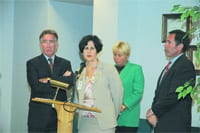Practice Environment for Mass. Physicians Declines for the 12th Straight Year
WALTHAM – The MMS Physician Practice Environment Index, an annual barometer of the physician practice environment in the state, has declined for the 12th consecutive year, according to a report released recently by the Massachusetts Medical Society (MMS), the statewide professional association of physicians. The index for 2005 dropped 1.8{06cf2b9696b159f874511d23dbc893eb1ac83014175ed30550cfff22781411e5} to 73.6, reaching yet another all-time low since its first year of measurement in 1992. The index is a statistical indicator of nine selected factors that shape the overall environment in which physicians provide patient care in Massachusetts and is compiled by the Medical Society.
“Massachusetts presents a disturbing contradiction in health care,” said Alan M. Harvey, M.D., M.B.A., president of the Massachusetts Medical Society. “While our health care facilities are some of the best in the world and our recent legislation to care for the uninsured is exemplary, we continue to see those at the center of our health care system — the physicians — operating in an unfriendly and weaker environment, year after year.”
Harvey said the constant decline of the index points to a striking and critical aspect of health care in Massachusetts: the fragile viability of physician practices. “Many of our physicians’ practices,” said Harvey, “are facing mounting financial and administrative burdens and are struggling as health care businesses. Given our practice environment and the increasing pressures physicians face, it’s no mystery that recruitment and retention of physicians in Massachusetts is so difficult.” Harvey said low reimbursements for services, growing administrative burdens including such programs as pre-authorizations for imaging tests and prescriptions, and the increasing costs of operating a practice are combining to put intense additional pressures on physicians of all specialties across the state.
Costs Soar
The medical society has calculated that the overall costs of maintaining a practice in the state, including professional liability costs, have increased 83.2{06cf2b9696b159f874511d23dbc893eb1ac83014175ed30550cfff22781411e5} for the 11-year period 1994-2005. The comparable increase for the U.S. was 67.5{06cf2b9696b159f874511d23dbc893eb1ac83014175ed30550cfff22781411e5}. Further, the average annual rate of increase in the cost of maintaining a practice in Massachusetts advanced at a rate 23{06cf2b9696b159f874511d23dbc893eb1ac83014175ed30550cfff22781411e5} faster than the rest of the nation.
Decline in 2005
The three biggest factors contributing to the 2005 decline in the Massachusetts index were increases in all of the following: (1) physicians’ cost of doing business; (2) New England Journal of Medicine physician employment ads; and (3) the ratio of median housing prices to median physician income. In further explaining the 2005 index’s decline, the medical society said the costs of maintaining a practice, including employer wages, office rental fees, and medical supplies, rose 3.9{06cf2b9696b159f874511d23dbc893eb1ac83014175ed30550cfff22781411e5} in 2005. The New England Journal of Medicine ad count jumped 15.4{06cf2b9696b159f874511d23dbc893eb1ac83014175ed30550cfff22781411e5} in 2005, suggesting that physician recruitment activity is strong and thus supporting the idea that workforce shortages remain a big problem in the state. Meanwhile, the ratio of housing prices to income rose 5.9{06cf2b9696b159f874511d23dbc893eb1ac83014175ed30550cfff22781411e5}, adding to a 10{06cf2b9696b159f874511d23dbc893eb1ac83014175ed30550cfff22781411e5} jump the year before.
The medical society’s annual research and analysis consistently have found that high housing costs and rising liability insurance premiums have been the biggest obstacles to recruitment and retention of physicians in the state.
Liability Impact
Professional liability insurance rates, the dominant force of the index in prior years, remained unchanged in 2005 in Massachusetts, but rose 7.4{06cf2b9696b159f874511d23dbc893eb1ac83014175ed30550cfff22781411e5} on average nationally. Despite steady rates in 2005, professional liability premiums for Massachusetts physicians continue to have enormous impact on physician practices.
Medical society research indicates that roughly half of the physicians practicing in the state are experiencing liability costs that exceed 10{06cf2b9696b159f874511d23dbc893eb1ac83014175ed30550cfff22781411e5} of their total business costs. Further, for the 13-year period ending in 2005, liability costs have jumped 132{06cf2b9696b159f874511d23dbc893eb1ac83014175ed30550cfff22781411e5} for physicians in Massachusetts, and rates are expected to rise again in 2006. The U.S. Physician Practice Environment, a companion index also compiled by the medical society that reflects the national practice environment, also fell again, at a rate of 2.2{06cf2b9696b159f874511d23dbc893eb1ac83014175ed30550cfff22781411e5}, for its 10th consecutive drop. It was only the fourth time in 12 years that the US index dropped faster than the state index.
For the 13-year period 1992-2005, a comparison of the Massachusetts index versus the US index shows that the deterioration in practice environment statewide has been faster than the rest of the nation over the 13-year period 1992-2005. Over that time span, the Massachusetts index has dropped an average of 3.56{06cf2b9696b159f874511d23dbc893eb1ac83014175ed30550cfff22781411e5}, while the US index is down 2.89{06cf2b9696b159f874511d23dbc893eb1ac83014175ed30550cfff22781411e5}.
The Medical Society developed the index to measure the impact of nine indicators that influence the practice environment for physicians in Massachusetts: (1) the number of applications to Massachusetts medical schools; (2) the percentage of physicians over 55; (3) the number of employment ads in the New England Journal of Medicine; (4) median physician income; (5) ratio of housing prices to median physician income; (6) professional liability costs; (7) physician cost of maintaining a practice, (8) mean hours per week spent in patient care; (9) annual number of visits per emergency department.
The complete Physician Practice Environment Index report may be read here:http://www.massmed.org/mmsindex



